· In the composition of blood plasma, water, salts and proteins are included. It covers 55 % of blood. RBC, WBC and platelets are included in blood corpuscles. It covers 45 % of blood.
(a) Mitral valve (b) Thebesius valve (c) Eustachian valve (d) tricuspid valve
(a) Coronary thrombosis (b) Defective leady valve (c) Arterial pulse (d) under developed atrium
(a) Damaged tissues (b) Blood platelets (c) Both (a) and (b) (d) Prothrombin
(a) Collagen, albumin, fibrinogen (b) Albumin, globulin, Actin (c) Globulin, albumin, collagen (d) Albumin, globulin, fibrinogen
(a) Auricular systole (b) ventricular systole (c) ventricular diastole (d) End of ventricular systole
(28) It shows pulmonary circulation :
(a) Left atrium (Oxygenated blood) - Lungs (deoxygenated blood ) - Right atrium
(b) Left atrium (deoxygenated blood ) - Lungs (oxygenated blood ) - Right atrium
(c) Left atrium (Oxygenated blood )- Lungs (deoxygenated blood )- Left atrium
(d) Right atrium (deoxygenated blood) - Lungs (oxygenated blood) - Left atrium
(29) Systolic pressure of heart
(a) 80 mm Hg (b) 120 mm Hg (c) 40 mm Hg (d) 320 mm Hg
(30) SA - Node is located at
(a) Left upper corner of the left atrium
(b) Left lower corner of the left atrium
(c) Right upper corner of the right atrium
(d) Righr lower corner of the right atrium
(31) Pathway of myogenic impulse conduction is
(a) SAN - AVN - Bundle of His - Purkinje fibers
(b) SAN - AVN - Punkinje fibers - Bundle of His
(c) AVN - SAN - Bundle of His - Purkinje fibers
(d) AVN - Bundle of His - SAN - Pukinje fibers
(32) In disease erythroblastosis foetalis
(a) Destroy the baby’s WBCs (b) A baby suffering from atherosclerosis
(c) Destroy the baby’s RBCs (d) An increasing in the number of RBCs
(33) A person having both antigen A and antigen B on the surface of RBCs :
(a) That person donot possess antibody in serum
(b) He can donate the blood to only having AB blood group
(c) He is universal recipient
(d) All the above
(34) responsible factor XI of blood clotting is
(a) Antiheamophilic globulin (b) Plasma thromboplasin antecedent
(c) Fibrin stabilizing (d) Hageman factor
(35) It is an important method for checking the health related problems of the heart.
(a) Xray (b) ECG (c) ELISA (d) CBC
(36) Blood group is due to
(a) Specific antigen on the surface of WBC
(b) Specific antibodies on the surface of RBC
(c) Specific antigen of the surface of RBC
(d) Type of haemoglobin in blood
(37) Leucopenia is the condition where
(a) Leuocytes decrease below 5000 per cubic mm of blood (b) Bone marrow is destroyed
(c) Total number of lymphocytes decrease from 2 % to 5 %
(d) Leucocytes increase above 6000 per cubic mm
(38) Carbonic anhydrase enzyme present in
(a) WBC (b) RBC (c) Blood plasma (d) Platelets
(39) The coagulation of blood occurs due to
(a) Destruction of RBC (b) Destruction of WBC
(c) Destruction of lymph (d) Destruction of blood platelets
(40) The valve present at the left auriculo - ventricular aperture is
(a) Tricuspid valve (b) Semilunar valve
(c) Mitral valve (d) Eustrachian valve
(41) Heart beat is
(a) Induced by hormones
(b) Voluntary process
(c) Dependent upon the stimulation by nerve complex
(d) Auto inducing
(42) At the time of auriculo ventricular valve shut, the sound is
(a) Lubb (b) Dubb (c) Lubb - dubb (d) Dhak - Dhak
(43) The systole is
(a) The relaxation of auricles (b) The relaxation of ventricles
(c) Relaxation of chambers of heat (d) Contraction of heart chambers
(44) Blood plasma is
(a) Acidic (b) Basic (c) Neutral (d) Variable
(45) A clot of blood contains
(a) Fibrinogen (b) Prothrombin (c) Thrombin (d) Fibrin
(46) Which one of the common anticoagulant is used for preserving blood ?
(a) Sodium hydroxide (b) Sodium chloride
(c) Sodium oxalate (d) Sodium bicarbonate
(47) Arteries carry oxygenated blood except
(a) Pulmonary (b) Cardiac (c) Hepatic (d) Systemic
(48) Increase in number of leucocytes beyond normal indicates
(a) Anemia
(b) Infection
(c) Increased defense against
(d) Non formation of RBC
(49) Largest number of white blood corpuscles are
(a) Eosinophils (b) Basophils (c) Neutrophils (d) Monocytes
(50) Blood is red but RBC are absent in
(a) Frog (b) Man (c) Rabbit (d) Earthworm
(51) Pace maker is
(a) Instrument for measuring heart beat
(b) Instrument for measuring pulse rate
(c) Auriculo - ventricular node that provides impulse for heart beat
(d) Sino - auricular node that provides impulse for heartbeat
(52) Which has the thickest walls ?
(a) Left ventricle (b) Right ventricle
(c) Left auricle (d) Right auricle
(53) Prothrombin required for blood clotting is produced in
(a) Stomach (b) Liver (c) Spleen (d) Pancreas
(54) Contraction of right ventricle pumps blood into
(a) Dorsal aorta (b) Pulmonary artery (c) Pulmonary vein (d) Coronary artery
(55) Dub sound is produced during closure of
(a) Semilunar valves (b) Bicuspid valve (c) Tricuspid valve (d) Both a & b
(56) In circulatory system, valves occur in
(a) Heart and blood vessels of both vertebrates and invertebrates
(b) Both vertebrate and invertebrate hearts
(c) Vertebrate heart only
(d) Invertebrate heart only
(57) In blood
(a) WBCs are more than RBCs (b) RBCs are more than WBCs
(c) RBCs are less than platelets (d) Platelets are less than WBCs
(58) Pericardial fluid is secreted by
(a) Myocardium (b) Parietal peritoneum
(c) Visceral peritoneum (d) None of the above
(59) Pulse pressure is
(a) Diastolic pressure (b) Systolic pressure
(c) Difference between b and a (d) Pressure in great veins
(60) Which one are granulocytes
(a) Neutrophils, basophils, lymphocytes (b) Eosinophils, basophils, monocytes
(c) Basophils, monocytes, lymphocytes (d) Neutrophils, eosinophils, basophils
(61) Lymph consists of
(a) RBCs, WBCs and plasma
(b) RBCs, proteins and platelets
(c) Alll components of blood except RBCs and some proteins
(d) WBCs and serum
(62) Find the matching pair :
(a) Lubb- sharp closure of AV valves at beginning of ventricular systole
(b) Dub - sudden opening of semilunar valves at the beginning of ventricular systole
(c) Pulsation of radial artery valves in blood vessels
(d) Initiation of heart beat - Purkinje fibers
(63) Valves which allow blood from ventricles into arteries and not in opposite direction are
(a) Aortic valve and mitral valve (b) AV valves and semilunar valves
(c) Bicuspid and tricuspid valves (d) Semilunar valves and tricuspid valve
(64) Bundle of His is a network of
(a) Muscle fibres distributed throughout heart walls
(b) Muscle fibres found only in ventricle wall
(c) Nerve fibres distributed in ventricles
(d) Nerve fibres found throughout the heart
(65) Artificial pacemaker is usually implanted to correct the defect in
(a) AV node (b) SA node (c) Purkinje fibers (d) Mitral valve
(66) Pulmonary vein carries oxygenated blood from
(a) Heart to its walls (b) Heart to lungs
(c) Lungs to heart (d) Heart to all body parts
(67) The sequence of cardiac cycle is
(a) Atrial systole - ventricular systole - joint diastole
(b) Atrial diastole - Atrial systole - ventricular diastole
(c) Atrial systole - ventricular diastole - ventricular systole
(d) ventricular diastole - ventricular systole - Atrial systole
(68) The blood returning to the heart from lungs via pulmonary vein has more
(a) RBC per ml of blood (b) Haemoglobin per ml of blood
(c) Oxygen per ml of blood (d) Nutrient per ml of blood
(69) Systemic heart refers to
(a) The two ventricles together in humans
(b) The heart that contracts under stimulation from nervous system
(c) Left auricle and left ventricle in higher ventebrates
(d) Entire heart in lower vertebrates
(70) In the heart of mammals the bicuspid valve is situated between
(a) Left auricle and left ventricle (b) Post caval and right caval
(c) Right auricle and left auricle (d) Right ventricle and pulmonary aorta
(71) The auriculo ventricular node in human heart was discovered by
(a) Hiss (b) Lewis (c) Ringer (d) William Harvey
(72) The beating of heart of man is heard on the left side because
(a) The left ventricle is toward the left side
(b) Both the ventricles are towards the left side
(c) Entire heart is on the left side
(d) The aorta is on the left side
(73) Purkinje’s fibres are special types of
(a) Muscle fibres located in heart
(b) Nerve fibres located in cerebrum
(c) Connective tissue fibers joining one bone to another bone
(d) Sensory fibers extending from retina into optic nerve
(74) The pericardium and the pericardial fluid help in
(a) Protecting the heart from friction, shocks and keeps it moist
(b) Pumping the blood
(c) Receiving the blood from various parts of the body
(d) None of the above
(75) For reaching left side of heart, blood must pass through
(a) Liver (b) Kidneys (c) Lungs (d) Brain
(76) The posterior venacava
(a) Divides into the hepataic portal veins (b) Opens into the left auricle
(c) Commences at the kidney (d) Begins at the hind end of abdomen
(77) Open circulatory system is present in
(p) Arthropods (q) Annelids
(R) Chordates (S) Molluscs (except cephalopods)
(a) P (b) P & Q (c) P & S (d) S & R
(78) ‘Heart of heart’ is
(a) SA - Node (b) AV - Node (c) Bundle of His (d) Purkinje fibres
(79) An oval depression called fossa ovalis is seen on
(a) Inter atrial septum (b) Inter ventricular septum
(c) Right auriculo - ventricular septum (d) Left auriculo - ventricular septum
(80) Which of the following statements is related to starling’s law of heart
(a) Greatar the stroke volume greater is the heart rate
(b) Greater the intial length of the cardiac muscle fibre, more the force of contraction of heart
(c) Greater the minute volume, greater is the heart rate
(d) Lesser the length of cardiac musle fibre greater is the force of contraction of heart
(81) An artificial pace - maker is implanted subcutaneously and connected to the heart in patients
(a) Having 90 % blockage of the three main coronary arteries
(b) Having a very high blood pressure
(c) With irregularity in the heart rhythm
(d) Suffering from arteriosclerosis
(82) The pace - setter in the heart is called
(a) Purkinje fibres (b) SA - Node (c) Papillary muscle (d) AV - Node
(83) Cardiac output is determined by
(a) Heart rate (b) Stroke volume (c) Blood flow (d) Both a & b
(84) Which of the following blood vessles has wide lumen
(a) Renal vein (b) Post venacava
(c) Renal artery (d) Right pulmonary artery
(85) In haemodialysis, patient’s blood is pumped from one of the arteries and mixing with X .
Blood is purified and it is then pumped into vein of the patient after adding Y to it.
X Y X Y
(a) Heparin , Anti heparin (b) Prothrombin, Thrombin
(c) antiheparin , Heparin (d) Prothrombin, Heparin
(86) Wave ‘T’ is representing in ECG as :
(a) Diastole of both atria and ventricles
(b) Systole of right atria and left ventricle
(c) Systole of the left atria and right ventricle
(d) Systole of both atria and ventricles
(87) Which one of the following vein breaks up into capillaries
(a) Renal vein (b) Hepatic vein (c) Pelvic vein (d) Pulmonary vein
(88) Serotonin in the blood
(a) Relaxes blood vessels (b) Prevents clotting of the blood
(c) Helps in clotting of blood (d) Constricts blood vessels
(89) The artery can be distinguished from the vein in having
(a) Thicker walls (b) More blood cell
(c) More plasma (d) Larger cavity
(90) The pulse beat is measured by the
(a) Artery (b) Capillary (c) Vein (d) None
(91) Carotid artery carries
(a) Impure blood from brain
(b) Oxygenated blood to anterior region of body or to brain
(c) Impure blood to kidney
(d) Oxygenated blood to heart
(92) Blood vessels carrying blood from lungs to heart
(a) Pulmonary artery (b) Pulmonary vein (c) Carotid artery (d) Coronary artery
(93) The diaphragm is supplied blood by
(a) Cardiac artery (b) Phrenic artery (c) Lingual artery (d) Lumber artery
(94) Iliac artery carries blood to the
(a) Lungs (b) Ileum (c) Hind limb (d) Brain
(95) The structure of which of the following consist of a layer of single cell thickness
(a) Blood capillary (b) Artery (c) Venule (d) Arteriole
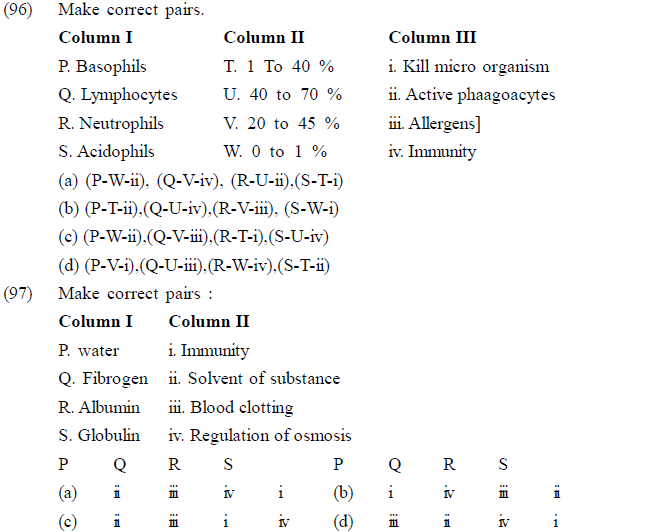
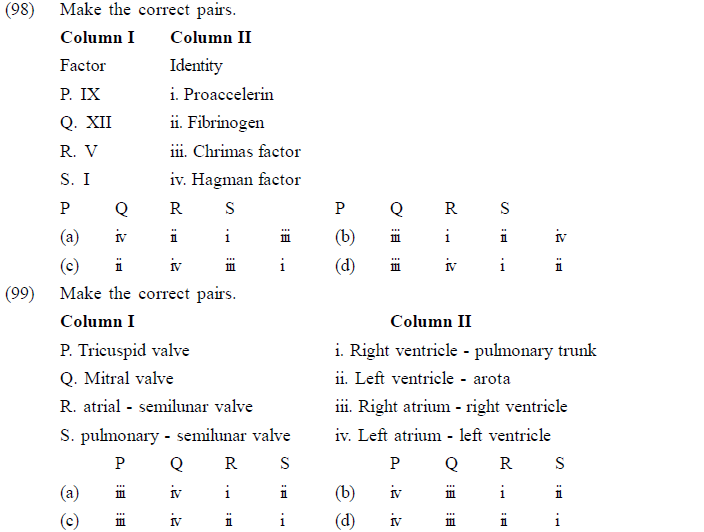
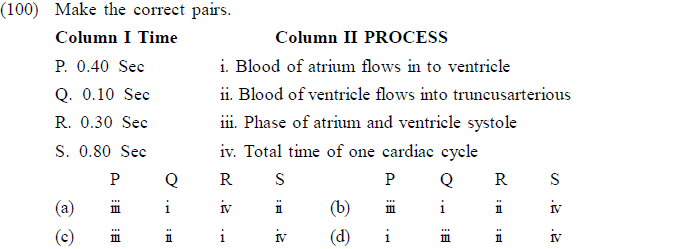
MORE THAN ONE TRUE OR FALSE STATEMENTS TYPE QUESTION
(TRUE = T; FALSE = F)
(101) According to statements find the correct option :
1. The composition of lymph is very much like that of the blood.
2. Lymph is resposible for immunity.
3. Lymphocytes added when lymph passes through small capillaries
4. Lymph is contain less fibrinogen than blood plasma
(a) FTFT (b) TTFT (c) TTTT (d) TTTF
(102) According to statements find the correct option :
1. Blood connects every cells, tissue and organs of body.
2. Blood is known as connective tissue proper.
3. Blood plasma constituted about 45 % of blood.
4. Blood is light yellow coloured and slightly viscous extra cellular fluid.
(a) TFTT (b) TTTT (c) TFFT (d) TTFF
(103) According to statements find the correct option :
1. Stuart factors are activated by : IX, VIII, IV and Phospholipid
2. Intitiated factors of this system are derived from the blood plasma
3. In intrinsic pathway blood clotting stats
4. PTA is activated by XIIa
(a) FTTF (b) TFFT (c) FTTT (d) TTTT
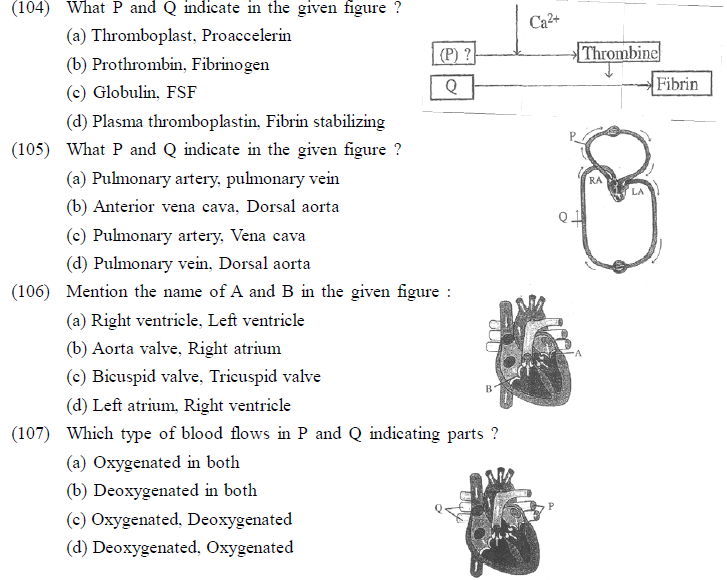
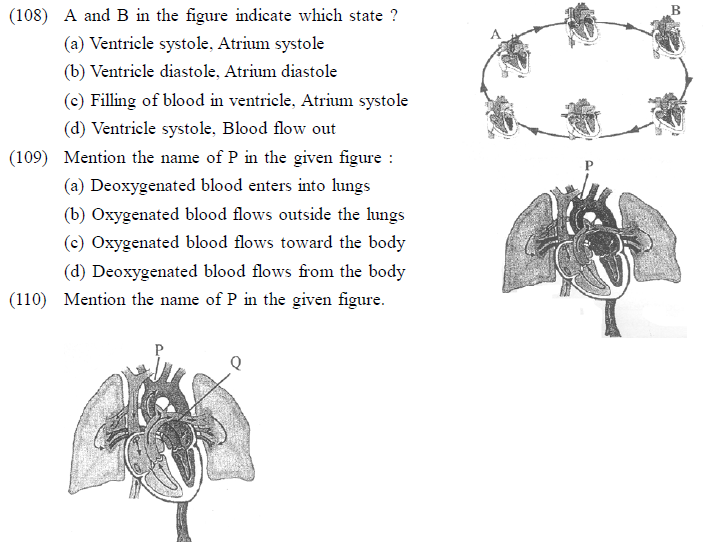
(a) Deoxygenated blood flows from the body
(b) Oxygenated blood flows from the lungs
(c) Oxygenated blood flows toward the body
(d) Deoxygenated blood enters into lungs
(111) What is the life span of RBC in humans ?
(a) 120 days (b) 210 days
(c) 220 days (d) 200 days
(112) What is found in the surrounding of wall of heart ?
(a) Pericardial cavity (b) Perineural cavity
(c) Pericardium (d) None of the above
(113) By which cause Dubb sound arises ?
(a) Closing of semilunar valve (b) Closing of bicuspid valve
(c) Closing of tricuspid valve (d) Both b and c
(114) Which is the pacemaker heart ?
(a) AV Node (b) SA Node (c) Purkinje fiber (d) Bundle of His muscle
(115) Where granular WBCs are produced ?
(a) Kidney (b) Liver (c) Small interstine (d) Bone marrow
(116) Which type of WBCs are found in maximum number ?
(a) Monocytes (b) Basophils (c) Acidophils (d) Neutrophils
(117) Which of the following is not useful in blood clotting.
(a) Fibrin (b) Calcium (c) Platelets (d) Bilirubin
(118) In which of the following close circulation is found ?
(a) Cockroach (b) Mosquito (c) Housefly (d) Tadpole
(119) The wall of which part of the heart is very thich ?
(a) Left atrium (b) Left ventricle (c) Right atrium (d) Right ventricle
(120) What is right for all veins ?
(a) They carry oxygenated blood (b) They carry Deoxygenated blood
(c) They directly open into vena cave (d) None of the above
(121) How lymph differs from blood ?
(a) More RBC and less WBC (b) Less RBC and more WBC
(c) RBC absent and less RBC (d) RBC absent and more WBC
(122) Which type of WBCs are found in maximum number ?
(a) Eosiophil (b) Nutrophil (c) Acidophil (d) Monocyte
(123) What is pacemaker ?
(a) Instrument measuring Heartbeats
(b) Instrument measuring big arteries
(c) Atrio - ventricular node, which provides stimulation for heart beating
(d) Artificial syno - auricular node, which provides stimulation for heart beating
(124) Which of the following statement is correct ?
(a) All veins carry deoxygenated blood
(b) All arteries carry deoxygenated blood
(c) All veins carry deoxygenated blood except one
(d) All arteries carry deoxygenated blood except one
(125) Regulation and initiation of heartbeat is indicated by
(a) AV Node - bundle of His muscule - SA node - purkinje fiber
(b) SA Node - purkinje fiber - AV Node - Bundle of His muscle
(c) Purkinje fiber - AV Node - SA node - Bundle of His muscle
(d) SA Node - AV Node - Bundle of His muscle - Purkinje fiber
(126) Where Mitral valve is located and it join, so by which ?
(a) Left atrium and left ventricle (b) Left atrium and Right ventricle
(c) Right atrium and Left ventricle (d) Right atrium and Right ventricle
(127) What is responsible for systole ?
(a) Entry of blood in lungs (b) Entry of blood in heart
(c) Blood flow out of heart (d) Blood flow out of vein
(128) What is the function of lymph ?
(a) Transport of O2 into brain (b) Transport of CO2 into lungs
(c) Bring interstitial fluid in blood (d) Bring RBC and WBC in lymph node
(129) Which is the correct statement for blood ?
(a) WBC is more than RBC (b) RBC is more than WBC
(c) RBC is less than platelets (d) Platelets is less than RBC
(130) Hepatic portal system starts from
(a) Digestive system to liver (b) Kidney to liver
(c) Liver to heart (d) Liver to Kidney
(131) Blood circulation that stats in capillaries and ends in capaillaries is called
(a) Portal circulation (b) Hepatic circulation
(c) Cardic circulation (d) None of these
(132) Which of the following carries glucose from digestive tract to liver
(a) Hepatic artaery (b) Hepatic portal vein
(c) Pulmonary vein (d) None of these
(133) Lymph (nodes) glands form
(a) Hormones (b) Lymphs (c) Antigens (d) Antibodies
(134) Which of the following is not a major organ of lymphatic system
(a) Lymph nodes (b) Thymus (c) Kidney (d) Spleen
(135) Lymph is colourless because
(a) WBC are absent (b) WBC are present (c) Heamoglobin is absent (d) RBC are absent
(136) Immunoglobulins are produced by
(a) Lymphocytes (b) Spleen (c) Leucocytes (d) Monocytes
(137) Which one of the following human organs is often called the “graveyard”?
(a) Albumin (b) Serum amylase (c) Globulin (d) Fibrinogen
(138) Which of the following human organs is often called the “graveyard” of RBC ?
(a) Spleen (b) kidney (c) Pancreas (d) Liver
(139) There is no DNA in
(a) Mature RBCs (b) Mature spermatozoa
(c) Hair root (d) Ovum
(140) In the ABO system of blood groups, if both antigens are present but no antibody, the blood group of the individual would be ?
(a) B (b) O (c) AB (d) A
(141) Make correct pairs :
Column - I Column - II
P. Anterior vena cava (i) Transport deoxygenated blood into lungs
Q. Posterior vena cava (ii) Transport the oxygenated blood outside the lungs
R. Pulmonary Artery (iii) Bring deoxygenated blood from lower part of the body to right atrium
S. Pulmonary vein (iv) Bring deoxygenated blood from upper part of the body to right atrium
(a) P-ii, Q-iv, R-iii, S-i
(b) P-iv, Q-i, R-ii, S-iii
(c) P-iv, Q-iii, R-ii, S-i
(d) P-iii, Q-iv, R-ii, S-i
(142) Which of the following is correct for all veins ?
(a) All veins transport deoxygenated blood
(b) All veins transport oxygenated blood
(c) They transport blood from organs to heart
(d) They transport blood from heart to organs
(143) Who much diastolic pressure is ?
(a) 120 mmHg (b) 80mmHg (c) 120/80mmHg (d) 40mmHg
(144) Which of the following are granular WBCs ?
(a) Neutrophils,Basophils, Lymphocytes (b) Eosinophil, Basophil, Monocytes
(c) Basophils, Monocytes, Lymphocytes (d) Neutrophils, Eosinophils, Basophils
(145) What P indicates in ECG ?
(a) End of atrium systole (b) Starting of atrium systole
(c) End of ventricle systole (d) Starting of ventricle systole
ASSERTION TYPES QUESTIONS
ASSERTION (A) AND REASON (R) TYPES QUESTIONS
(a) Both A and R are true and R is correct explanation of A
(b) Both A and R are true but R is not correct explanation of A
(c) A is true but R is not true
(d) A is not true but R is true

